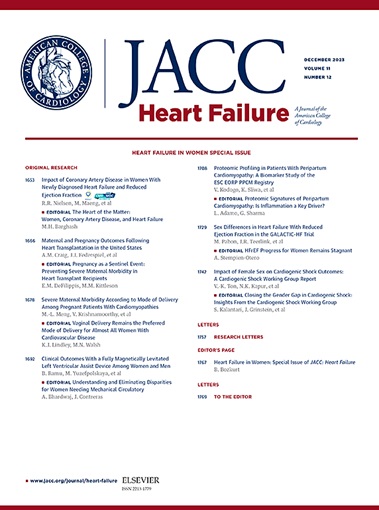缺血性与非缺血性心肌病的心脏再同步化疗法:7 项随机临床试验的患者层面 Meta 分析。
IF 10.3
1区 医学
Q1 CARDIAC & CARDIOVASCULAR SYSTEMS
引用次数: 0
摘要
背景:关于心脏再同步化疗法(CRT)是否能使非缺血性心肌病(NICM)与缺血性心肌病(ICM)患者获得更好的临床和超声心动图结果的数据相互矛盾:作者对 7 项 CRT 临床试验进行了荟萃分析,以确定心肌病病因与临床和超声心动图结果之间的关联:作者使用贝叶斯层次Weibull生存回归模型分析了患者层面的数据,以确定心肌病病因与全因死亡或心衰住院(HFH)时间之间的关联。线性回归用于评估心肌病病因与超声心动图测量之间的关系:在纳入的 6252 名患者中,4717 人(75%)为男性,中位年龄为 66 岁(IQR:58-73 岁),3704 人(59%)患有 ICM,3778 人(60%)接受了 CRT。CRT 延长了 HFH 或全因死亡的时间(HR:0.67;95% 可信区间 [CrI]:0.56-0.82;P <0.001),心肌病病因无差异(HR 比值:1.06 [95% CrI:0.87-1.29];P = 0.57)。同样,CRT 延长了全因死亡的时间(HR:0.71 [95% CrI:0.55-0.93];P = 0.019),不同病因的心肌病没有差异(HR 比值:1.06 [95% CrI:0.80-1.43];P = 0.70)。2,430名(39%)患者的超声心动图数据显示,CRT对NICM患者左室射血分数、左室舒张末期直径和左室收缩末期直径的改善更大:尽管与 ICM 患者相比,CRT 能使 NICM 患者的左室射血分数增加更多,心室尺寸缩小更多,但与心肌病的病因无关,CRT 能显著延长 HFH 或全因死亡的时间。需要进一步研究如何改进 CRT 患者的选择。本文章由计算机程序翻译,如有差异,请以英文原文为准。
Cardiac Resynchronization Therapy in Ischemic Versus Nonischemic Cardiomyopathy
Background
Data on whether cardiac resynchronization therapy (CRT) results in better clinical and echocardiographic outcomes in patients with nonischemic cardiomyopathy (NICM) vs ischemic cardiomyopathy (ICM) are conflicting.
Objectives
The authors conducted this meta-analysis of 7 clinical trials of CRT to determine the association between etiology of cardiomyopathy and clinical and echocardiographic outcomes.
Methods
The authors analyzed patient-level data using Bayesian Hierarchical Weibull survival regression modeling to determine the association between etiology of cardiomyopathy and time to all-cause death or heart failure hospitalization (HFH). Linear regression was used to assess the association between etiology of cardiomyopathy and echocardiographic measurements.
Results
Of 6,252 patients included, 4,717 (75%) were men, median age was 66 years (IQR: 58-73 years), 3,704 (59%) had ICM, and 3,778 (60%) received CRT. CRT increased the time to HFH or all-cause death (HR: 0.67; 95% credible interval [CrI]: 0.56-0.82; P < 0.001) with no difference by etiology of cardiomyopathy (HR ratio: 1.06 [95% CrI: 0.87-1.29]; P = 0.57). Likewise, CRT increased the time to all-cause death (HR: 0.71 [95% CrI: 0.55-0.93]; P = 0.019) with no difference by etiology of cardiomyopathy (HR ratio: 1.06 [95% CrI: 0.80-1.43]; P = 0.70). Echocardiographic data that were available for 2,430 (39%) patients showed that CRT improvements in left ventricular ejection fraction, left ventricular end-diastolic diameter, and left ventricular end-systolic diameter were larger for patients with NICM.
Conclusions
Although CRT led to greater increases in left ventricular ejection fraction and reductions in ventricular dimensions for patients with NICM compared with those with ICM, CRT significantly increased the time to HFH or all-cause death independently of the etiology of cardiomyopathy. Further studies on improving patient selection for CRT are needed.
求助全文
通过发布文献求助,成功后即可免费获取论文全文。
去求助
来源期刊

JACC. Heart failure
CARDIAC & CARDIOVASCULAR SYSTEMS-
CiteScore
21.20
自引率
2.30%
发文量
164
期刊介绍:
JACC: Heart Failure publishes crucial findings on the pathophysiology, diagnosis, treatment, and care of heart failure patients. The goal is to enhance understanding through timely scientific communication on disease, clinical trials, outcomes, and therapeutic advances. The Journal fosters interdisciplinary connections with neuroscience, pulmonary medicine, nephrology, electrophysiology, and surgery related to heart failure. It also covers articles on pharmacogenetics, biomarkers, and metabolomics.
 求助内容:
求助内容: 应助结果提醒方式:
应助结果提醒方式:


